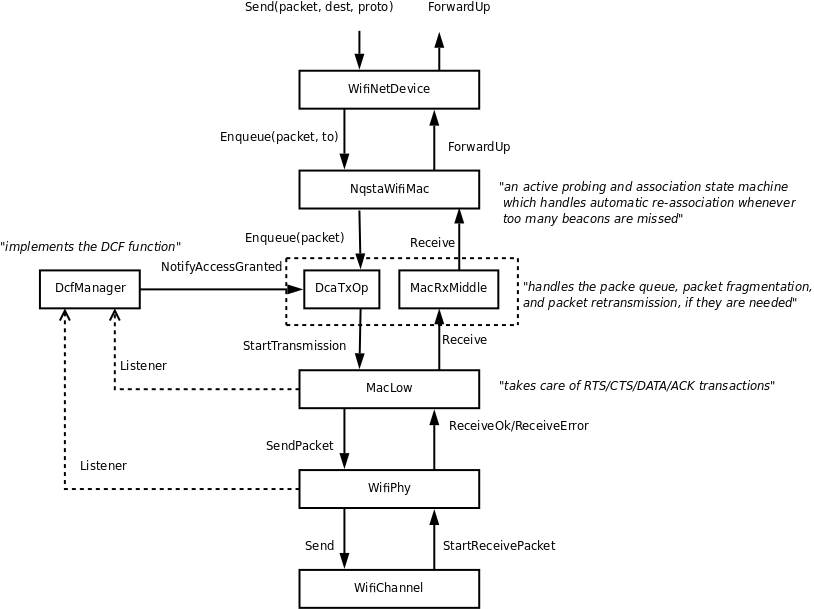Wifi Models
[Devices]

|
Wifi Models Overview
The set of 802.11 models provided in ns-3 attempts to provide an accurate MAC-level implementation of the 802.11 specification and to provide a not-so-slow PHY-level model of the 802.11a and 802.11b specifications.The current implementation provides roughly 4 levels of models:
- the PHY layer models
- the so-called MAC low models: they implement DCF and EDCAF
- the so-called MAC high models: they implement the MAC-level beacon generation, probing, and association state machines.
- a set of Rate control algorithms used by the MAC low models.
We have today 6 MAC high models, 3 for non QoS MACs and 3 for QoS MACs.
a)non QoS MACs:
- a simple adhoc state machine which does not perform any kind of beacon generation, probing, or association. This state machine is implemented by the ns3::AdhocWifiMac class.
- an active probing and association state machine which handles automatic re-association whenever too many beacons are missed is implemented by the ns3::NqstaWifiMac class.
- an access point which generates periodic beacons, and which accepts every attempt to associate. This AP state machine is implemented by the ns3::NqapWifiMac class.
b)QoS MACs:
- like above but these MAC models are also able to manage QoS traffic. These MAC layers are implemented respectively by ns3::QadhocWifiMac, ns3::QstaWifiMac and ns3::QapWifiMac classes. With these MAC models is possible to work with traffic belonging to four different access classes: AC_VO for voice traffic, AC_VI for video traffic, AC_BE for best-effort traffic and AC_BK for background traffic. In order to determine MSDU's access class, every packet forwarded down to these MAC layers should be marked using ns3::QosTag in order to set a TID (traffic id) for that packet otherwise it will be considered belonging to AC_BE access class. How TIDs are mapped to access classes are shown in the table below.
TID-AccessClass mapping:
| TID | Access class |
| 7 | AC_VO |
| 6 | AC_VO |
| 5 | AC_VI |
| 4 | AC_VI |
| 3 | AC_BE |
| 0 | AC_BE |
| 2 | AC_BK |
| 1 | AC_BK |
The MAC low layer is split in 3 components:
- ns3::MacLow which takes care of RTS/CTS/DATA/ACK transactions.
- ns3::DcfManager and ns3::DcfState which implements the DCF function.
- ns3::DcaTxop or ns3::EdcaTxopN which handle the packet queue, packet fragmentation, and packet retransmissions if they are needed. ns3::DcaTxop object is used by non QoS high MACs. ns3::EdcaTxopN is used by Qos high MACs and performs also QoS operations like 802.11n MSDU aggregation.
The PHY layer implements a single 802.11a model in the ns3::WifiPhy class: the physical layer model implemented there is described fully in a paper titled "Yet Another Network Simulator", available at: http://cutebugs.net/files/wns2-yans.pdf and recently extended to cover 802.11b physical layer.
The Wifi Model also provides a set of Rate control algorithms:
- ns3::ArfWifiManager
- ns3::AarfWifiManager
- ns3::IdealWifiManager
- ns3::CrWifiManager
- ns3::OnoeWifiManager
- ns3::AmrrWifiManager
- ns3::CaraWifiManager
- ns3::AarfcdWifiManager
Wifi Tracing Model
Like all ns-3 devices, the Wifi Model provides a number of trace sources. These trace sources can be hooked using your own custom trace code, or you can use our helper functions to arrange for tracing to be enabled on devices you specify.Upper-Level (MAC) Hooks
From the point of view of tracing in the net device, there are several interesting points to insert trace hooks. The first is at the interface between the device and higher layers. We provide trace hooks at this point in packet flow, which corresponds to a transition from the network to data link layer, and call them collectively the device MAC hooks.The first trace hook is called "Rx" and is fired using the ns3::WifiNetDevice::m_rxLogger trace hook. The perspective here is looking down into the WifiNetDevice so a receive indicates a packet being sent up from the channel to be forwarded up to higher layers.
The second trace hook is called "Tx" and is fired using the ns3::WifiNetDevice::m_txLogger trace hook. This trace hook indicates a packet has been sent from higher layers down to the net device for transmission onto the network.
Low-Level (PHY) Hooks
Another interesting place to insert trace hooks is in the state machine that is driving the actual device transmission and reception logic. We provide the following hooks to instrument the lower levels of the device.First, we provide a trace hook to indicate state changes. This trace source is called "State" and is fired using the ns3::WifiPhyStateHelper::m_stateLogger trace source.
We also provide a trace hook to indicate the successful reception of a packet from the channel. This trace source is called "RxOk" and is accessed using the ns3::WifiPhyStateHelper::m_rxOkTrace trace source.
There also exists a trace hook to indicate an unsuccessful reception of a packet from the channel. This trace source is called "RxError" and is accessed using the ns3::WifiPhyStateHelper::m_rxErrorTrace trace source.
There is a trace hook to indicate that transmission of a packet is starting onto the channel. This trace source is called "Tx" (don't confuse it with the higher layer "Tx" hook) and is fired using the ns3::WifiPhyStateHelper::m_txTrace trace source.
Remote Station Hooks
We provide access to changes in the the per-remote-station RTS counter through the "Ssrc" trace source which is fired using the ns3::WifiRemoteStation::m_ssrc trace hook.Finally, we provide access to the per-remote-station SLRC couter that indications the number of retransmissions of data. Changes to this counter are traced using the ns3::WifiRemoteStation::m_slrc source.
Layer 2 Stack Overview

Overview of the Wifi L2 sublayers traversed for transmitting and receiving a packet
 1.5.8
1.5.8